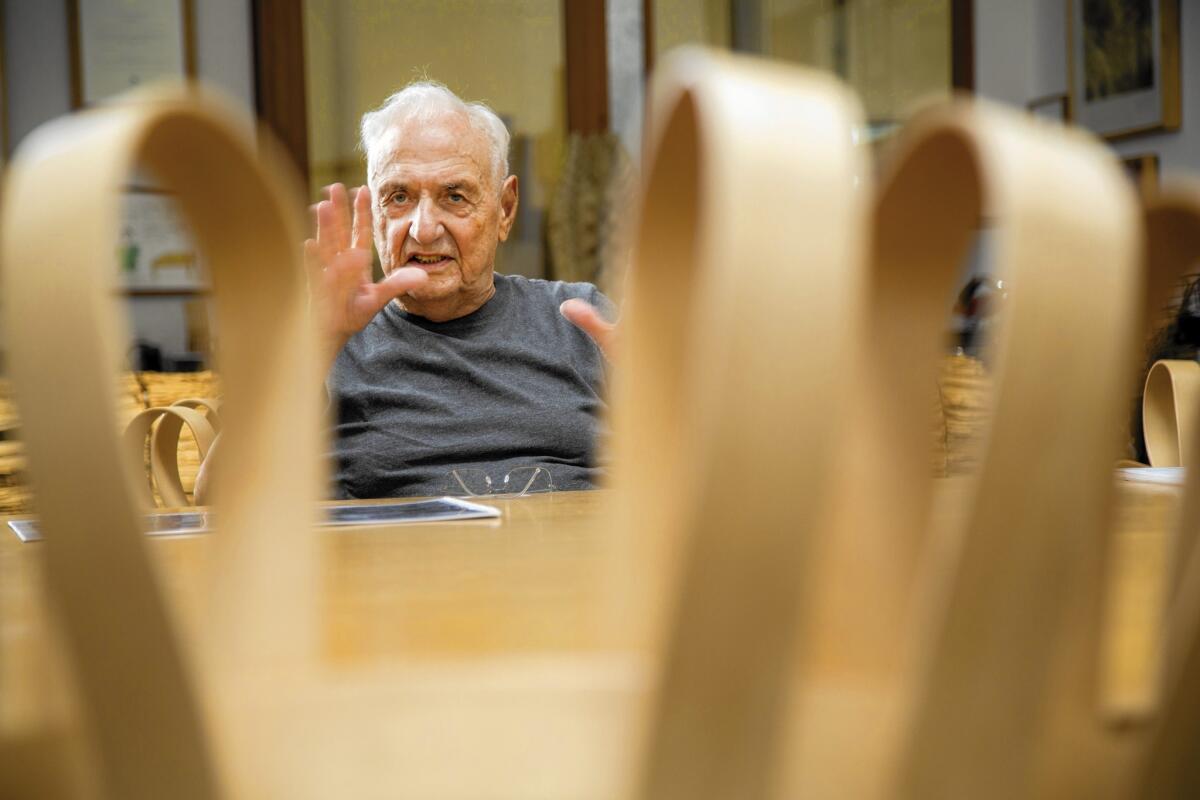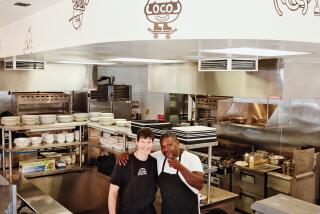Watts made its mark on Frank Gehry, now the architect is returning the favor

You could say Chuck Norris had a hand in bringing a Frank Gehry building to Watts.
Back in the late 1960s — Gehry can’t be entirely sure of the year — the architect, then in the vicinity of 40, decided to take up karate as a way of getting in shape. He ended up at Norris’ West L.A. dojo, where on the first day the future action star lined up his students (Gehry and a roomful of teenagers) and proceeded to do spin kicks within millimeters of each of their noses.
“We were standing there in the little white suits,” recalls Gehry, seated in a photo-lined conference room at his Playa Vista architectural office. “And he never missed. I got fascinated with the precision of how that worked.”
“Fascinated” would be an understatement. Gehry became so obsessed with the art of battle, he began private lessons with a professional boxing coach in Watts. He can’t remember the man’s name. “That was 46 years ago,” he explains. But he remembers the improvised gym in a small garage off Central Avenue and how his coach taught him how to spar and occasionally sent him home with a limp.
SIGN UP for the free Essential Arts & Culture newsletter >>
It wasn’t Gehry’s first time in Watts. But through his weekly boxing lessons, Gehry soaked up the neighborhood’s landscape of modest bungalows, Art Deco storefronts and barracks housing projects hurriedly erected during World War II — not to mention the empty lots left behind by the Watts uprising of 1965, which he had watched unfold live on television.
Almost half a century later, Gehry is once again traveling to Watts on a regular basis, but not because he’s perfecting his left hook.
On Saturday morning, he will unveil his firm’s pro-bono design for the new campus of Children’s Institute Inc., an L.A.-based social services organization that provides development and clinical services to children and families dealing with poverty and violence. The estimated $35-million project will occupy the better part of a city block at 102nd Street and Compton Avenue, replacing a converted hospital building from the 1960s.
“It’s simple, it’s direct, it has a nice humanity about it,” Gehry says of the design, which consists of boxy, two-story forms united by shining metal roofs at Gehry-esque angles.
The new campus will bring much-needed play areas and therapy rooms designed for children and adolescents, as well as art-making and community gathering spaces. But CII’s leaders also hope it will introduce a positive cultural symbol into a neighborhood that, despite a few bright spots, still contends with serious poverty and crime issues. Median household income in Watts is little more than $25,000 per year, near the bottom among Los Angeles neighborhoods, according to U.S. Census Bureau figures. And in the last six months, Watts has been the site of 274 violent crimes, including two homicides, per L.A. Police Department data. (As a point of comparison, L.A.’s Fairfax District had 61 violent crimes with no homicides during the same period, and has a median household income more than 2 1/2 times that of Watts.)
“Sometimes there’s this sense of why is Frank Gehry doing a building in Watts,” says Nina Revoyr, CII’s executive vice president and chief operating officer. “Low-income communities need magic and beauty just as much as wealthy ones — perhaps even more so. Why do we even need to ask?”
Jacqueline Atkins grew up in Watts in the ‘70s and ‘80s, when the neighborhood began to contend with the toxic effects of the crack epidemic. A licensed clinical psychologist, she has worked at CII’s Watts office and now serves as the organization’s regional vice president of programs.
“Having something like Gehry’s building, seeing something so beautiful ... that can really give you a sense of yourself,” she says. “My family doesn’t live here anymore, but they’re overwhelmed by the idea of a structure of this magnitude coming to Watts.”
For the Pritzker Prize-winning architect behind the Guggenheim Museum Bilbao and Disney Hall, the project is part of a renewed focus on Los Angeles. Gehry is currently at work on a massive mixed-used commercial project on the Sunset Strip and a pro-bono hydrology study of the Los Angeles River.
“I don’t have to fly around so much,” he says of the L.A. projects. “Plus, I’m in a place in my life where I can do this. I love doing it. My people love doing it.”
The Watts campus and the L.A. River study aren’t Gehry’s first charitable projects. The architect created designs for the Jazz Bakery in Culver City and a house in New Orleans for the Make It Right Foundation. He also helped establish Turnaround Arts: California, a not-for-profit that helps provide arts education to high-poverty, low-performing schools. As part of the project, he has traveled to Hoopa Indian territory in Northern California to meet with kids at a local elementary school.
“I think he would be profoundly upset if he died and were remembered as an architect of rich people’s houses and fancy buildings,” says Paul Goldberger, author of the new biography “Building Art: The Life and Work of Frank Gehry.” “His whole life he has cared for the well-being of society. He’s never been conservative politically. And he really believes that an architect’s skills should go at least in part toward making the world better.”
------------
FOR THE RECORD
Sept. 12, 8:01 a.m.: An earlier version of this article misstated the last name of author Paul Goldberger as Goldberg.
------------
At a time when he can cherry-pick his projects, Gehry has chosen Watts. And in CII he has found an interesting client.
Founded in 1906 by a female probation officer, the organization began life in Los Angeles as the Big Sister League to help young women in crisis (namely, those who were unmarried and pregnant).
Today, Children’s Institute Inc. offers a range of services for children and families dealing with domestic abuse, gang violence and poverty in locations across L.A. There are support groups, technology labs, art classes and mental health and counseling services, such as Project Fatherhood, launched two decades ago, to keep men involved in their children’s lives in constructive ways. CII also operates a number of Head Start programs around Central and South Los Angeles.
In the design of its existing spaces, CII has been very conscientious about creating environments that do not feel institutional. The group’s headquarters, at the corner of Temple and Alvarado streets in Westlake, are housed in a converted vending-machine warehouse whose entrance is framed by fragrant citrus trees and rosemary bushes. The bright, loft-like interiors feel more like a graphic design office than clinical center. (The award-winning renovation was done by the Santa Monica-based firm Koning Eizenberg Architecture.)
“The idea is to take away the stigma of mental health services,” says Marion Dave, the regional vice president who oversees the Watts location. “The idea is people don’t know if you’re coming in for an art class or mental health services.”
The current CII center in Watts is in a refurbished portion of a half-century-old hospital that wasn’t designed to be, well ... hospitable. A pair of low-slung rectangular buildings have, as their spine, uninspiring linoleum-lined hallways illuminated by neon lighting. In one un-renovated portion, a sign helpfully points to an “STD Waiting Room.”
More significantly, while the organization has done a good job sprucing up one 6,000-square-foot wing with bright paint and a colorfully furnished waiting room, the building’s layout doesn’t work for all the activities CII offers.
“What you don’t see here,” Revoyr says, “is a space for kids. Something with a dedicated art room, a play area, kid-friendly therapy rooms — things that will make them feel like this is their space.”
When CII’s leaders began to discuss the possibility of construction, the furthest thing from their minds was commissioning the services of a high-profile architect.
“When we first imagined this, we imagined four walls and a coat of paint,” exclaims Dave. “We never imagined Frank Gehry!”
But board member Gelila Assefa Puck, a fashion designer who is married to chef Wolfgang Puck, knew Gehry and decided to lay out a call on behalf of the organization. Gehry responded immediately.
“I said, ‘Of course we’ll do this,’ ” he recalls. “It’s a no-brainer.”
Gehry himself comes from a humble, working-class family. (“My father was a Hell’s Kitchen kid,” he says, referring to the Manhattan district that teemed with gangs in the early 20th century.) And the opportunity to work in Watts proved beguiling for historical reasons. For one, Gehry has always been intrigued by the Watts Towers; he met their creator, Simon Rodia, while Rodia was in the process of finishing them. “He was an artist,” says Gehry. “Very quiet. And very anxious to have these things last.”
NEWSLETTER: Get the day’s top headlines from Times Editor Davan Maharaj >>
He was also intrigued by the building’s location. “This was right in the middle of where the riots were,” he explains. The current CII site, in fact, abuts the stretch of 103rd Street once known as “Charcoal Alley,” since every building on the strip had been incinerated during the 1965 uprising.
The new design — overseen by Gehry but spearheaded by two of the firm’s younger architects, Sam Gehry (the architect’s son) and Precious Aiyeloja — will provide CII with 50,000 square feet of flexible space. And the architects managed to tuck most of the parking underneath the building, so that the entrance isn’t blocked off from the sidewalk by an ocean of parking.
“You can come right into a plaza that’s covered in glass,” says Gehry. “And along the edges there are these gardens, so it feels very welcoming. ... The scale is quite nice. It fits into the neighborhood.”
Atkins says she was blown away by the renderings when she first saw them. “It’s so beautiful,” she says. “I really see something about instilling hope. The idea that things will get better if I invest in myself.”
(A model of the CII design will be on view at the L.A. County Museum of Art retrospective of Gehry’s work, which opens Sunday.)
Revoyr’s development team has identified about half of the money necessary to cover the building’s costs. She hopes to complete fundraising in time to break ground in 2018. Also on board for that phase is Inglewood architecture office (fer) studio, which is helping oversee construction.
Gehry knows that a single building won’t halt the neighborhood’s cycles of poverty and violence. “But I believe in the tooth fairy,” he says. “I think if you do something that has an invitation and a scale and a nice feel to it, that’ll engender some kind of respect.”
Plus, he’s always happy to pay his old boxing hangout a visit. This time, without having to worry about getting a cracked rib.
Twitter: @cmonstah
ALSO:
What’s Frank Gehry designing for the Jazz Bakery? Drawings shown at LACMA
A ‘linear Central Park’: Frank Gehry’s plan for L.A. River takes shape
Amid an era rife with rebellion, the Watts riots were a wake-up call
More to Read
The biggest entertainment stories
Get our big stories about Hollywood, film, television, music, arts, culture and more right in your inbox as soon as they publish.
You may occasionally receive promotional content from the Los Angeles Times.











